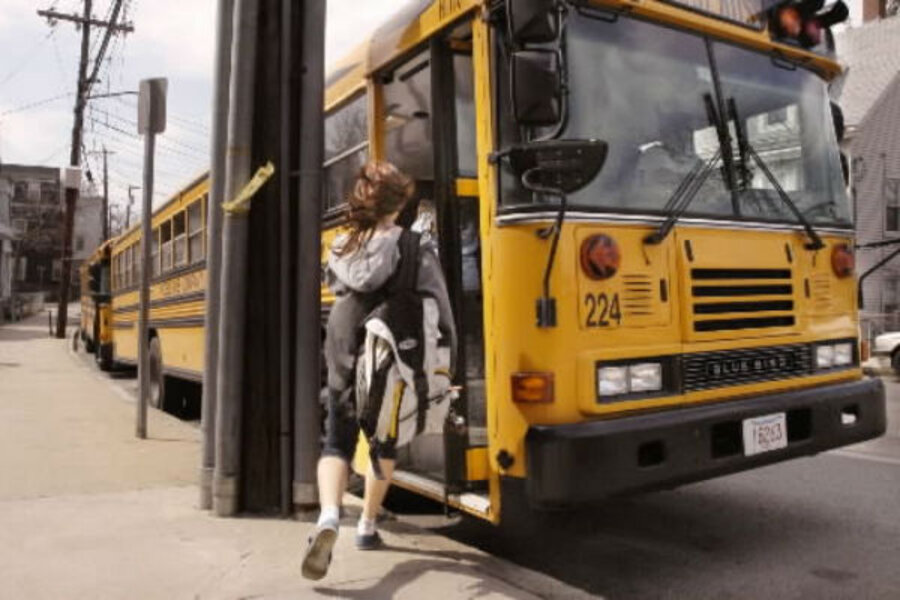Bullied bus monitor reaction: Teach victims to deal with bullies
Loading...
When an editor from The Christian Science Monitor called to ask what I thought of the much-viewed video of middle school bus-riders bullying the bus monitor, I looked it up and watched it for the first time. The editor called me because of an earlier post in which I described different types of bullies and victims, and to me, this looks like a classic bully/classic victim situation.
What’s most shocking is the fact that she’s an adult, and these are children. In theory, she should have the authority to make it stop. I don’t know her, so I can’t say anything with any certainty. All I can say is that her demeanor and the way she handles it mimic exactly what a victim the same age as the tormentors would do. An adult comfortable wielding authority would never handle it that way. She would be on her cell phone to the principal right then and there. I very strongly suspect that incidents not unlike this happened to her back when she was a kid on the bus and did not have any authority.
So I’m left with a lot of questions about the choices other adults made. Why did the school district hire someone so passive as a middle school bus monitor — one of the toughest disciplinary jobs around? If she can’t defend herself, how can she defend other children who may be victims of these boys? (Okay, judging from the responses to my last blog, I’m going to hear a chorus of “she’s blaming the victim.” A reminder, I am in no way defending the perpetrators or suggesting soft penalties. Can we get out of the blame-game all together and solve the problem? Because if we don’t, this kind of stuff is just going to keep happening.) Where was the bus driver? Why on earth did he or she just allow that to happen? One of the chief ways adults in education keep control over the kids, who always outnumber them, is by acting as allies, and the driver dropped the ball. Also, if he/she won’t defend a colleague, where does that leave a victimized kid on the bus?
This is why just punishing bullies is not enough. I’ll go back to the rape analogy I used in my previous blog. I don’t want to be raped and then have the perpetrator punished. I mean, if I am raped, I want the perp to pay, but first and foremost, I don’t want to be raped at all. I want to know how to prevent the attack. If I am attacked, and someone can help me, I want them to help. It’s not about blaming the victim; it’s about reducing the number of victims altogether.
What I suspect is playing out on that video is the behavior of a lifelong victim and a lifelong passive observer. The adult bus driver did what kids often do when they see someone being bullied — nothing. They fear becoming victims themselves. By the time someone reaches adulthood, and when they are in a position of authority, they should be past that, but if that basic fear is never dealt with, it lingers and we see what we saw in the video. The monitor, as I said, also handles it the way a kid would, hoping her tormentors will get bored, when her passivity actually only seems to encourage it. (“Just ignore them and it will stop” — a horrible piece of advice given all too often.)
I have no idea what may have happened to any bullies the monitor encountered in her past. I doubt it matters. Kids who are victimized or who may observe someone being victimized have to be empowered, and while the bullies must be dealt with, the only way to prevent future bullying is to teach potential victims how to deal with bullies. Give them skills they can use later in life when faced with an abusive spouse or tyrannical boss. A classic victim has to learn how reach out for help, and schools must respond, using appropriate levels of conflict mediation and punishment for perpetrators.
This isn’t a “zero-tolerance,” one-size-fits-all approach. If some of those kids really are capable of empathy, strong punishment is called for, but it’s the least important element in changing the behavior. At some point, they need to face their victim in a controlled environment designed to tap into that empathy. I really have seen this make a profound and positive difference for both the bully and the victim. If one or more of the kids smirk or are obviously insincere during the initial investigation, then yes, their punishment is harsher, and there is no conflict mediation. They are directed to have absolutely no future contact with the victim whatsoever. Parents and lawyers will squawk about this as unfair or arbitrary, but parole boards take attitude into consideration all the time. Why shouldn’t schools?
If we focus on teaching, rather than just punishing, then maybe we’ll have fewer people in their 60s who are so entrenched in the victim role that they feel powerless against children.






